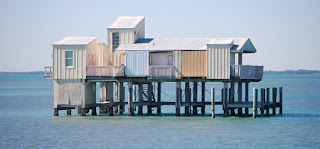"Off Key Biscayne is a renegade village on stilts where weekend residents live by their own laws. Their town hall is a floating Bikini Club that swings both day and night." (May 1967 issue, Argosy magazine)
It was already too late in 1967 for titillated readers to fly off to Miami to check this place out; it had succumbed to storm and fire a year before and passed into legend. But you can just see Humphrey Bogart or Errol Flynn in a movie version of it, with Miss Bacall at the bar.
Today you can take a "three hour tour" to visit what remains of Stiltsville on the sand banks of Biscayne Bay, but it would have been a lot more fun to have visited it during its heyday from the early 1930s to the early 1960s when 27 structures built on barges, boats or piers dotted the blue waters. Miami is still the bad boy of American cities, but you can imagine how they, back in the day, turned the Prohibition era to their advantage and had a great time doing it. The little rule about gambling being legal a mile offshore didn't escape their notice, and littler things like liquor licenses after 1933 didn't even get their notice.
"Crawfish Eddie" Walker is said to have built the first stilt house, inaugurating three decades of wild partying history. He began selling bait and beer, and soon his trademark crawfish chowder. Jimmy Buffett would have gotten along famously with this guy! Hurricanes over the years decimated the shacks and clubs on a regular basis, and Eddie's disappeared in storm and fire in 1950.
The more ambitious and expensive Calvert Club was built in the late 1930s, followed by the Quarterdeck Club. Shady businessman Harry Churchville grounded a yacht on the flats and opened the Bikini Club, featuring free drinks for ladies so attired. During its all-too-brief three year existence, Florida's elite including a fun-loving governor were regulars until the unfortunate lack of a liquor license brought on a raid. Life magazine described Stiltsville in its prime as "an extraordinary American community dedicated solely to sunlight, salt water and the well-being of the human spirit." Amen, brother.
The end to the good times came in the early 1960s with more hurricanes and fires; new building permits for the clubs were denied, and as the National Park expanded, commercial operations were banned in 1969. The legend lives, though, on television and in novels. Carl Hiaasen, mordant observer of South Florida's casual relationship with law and virtue, has featured Stiltsville as it was and is in three books.
If you were drifting on a boat late in the evening near the Bay's sand bars you'd hear the ripple of laughter, the clatter of the dice and the clink of martini glasses drift over the shallow water. They knew how to live, back in the day.



Some of them were still there in '81 when I went to UM. Never made it out to see them, but heard they were used for parties and other illicit activities after they were abandoned.
ReplyDelete